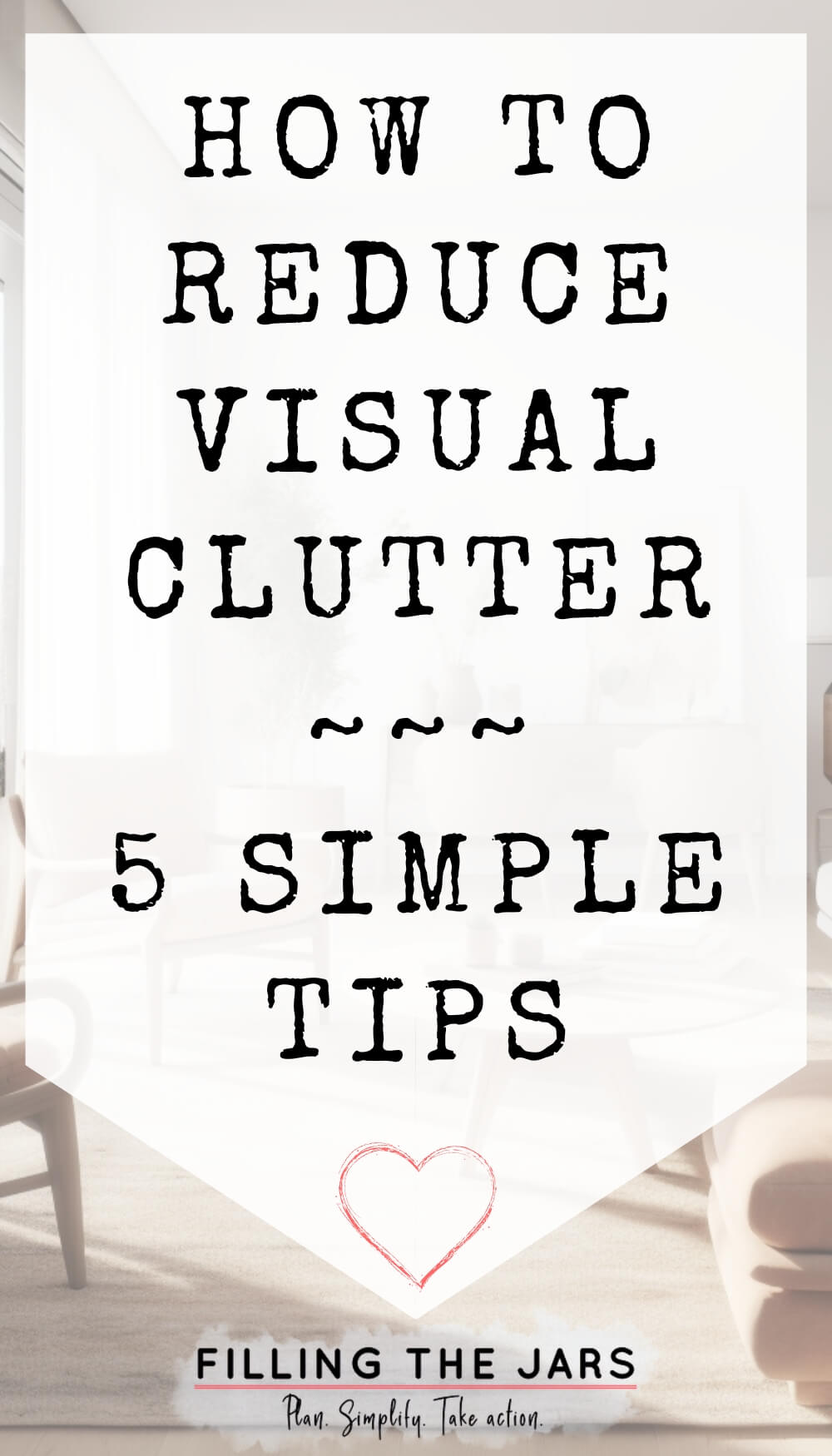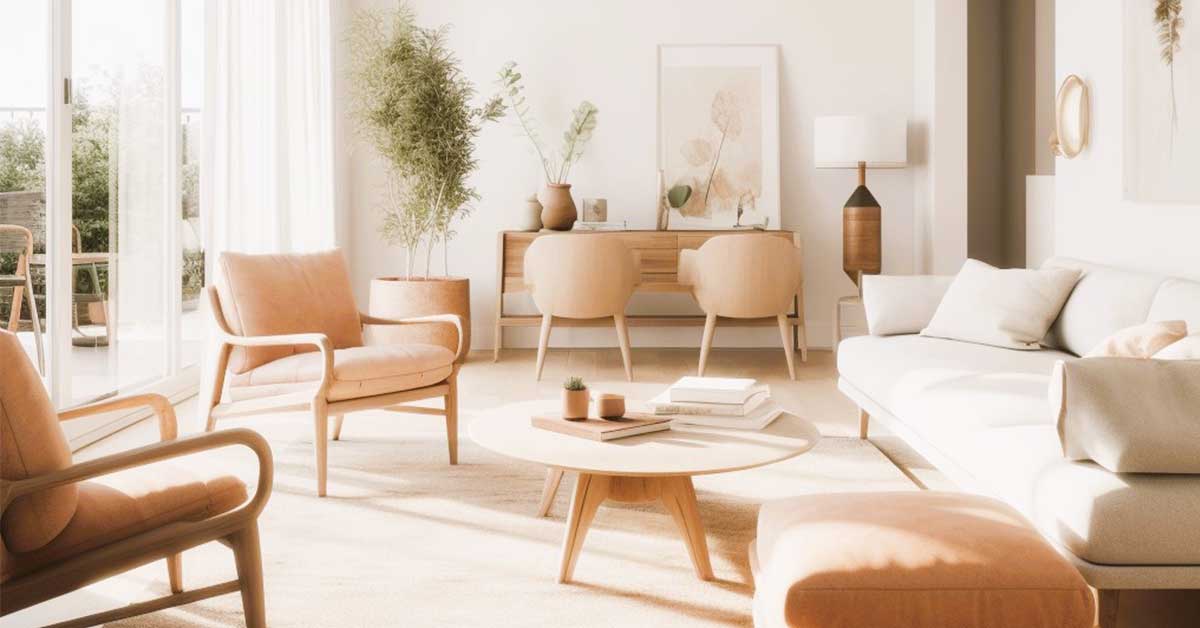Do you ever feel overwhelmed by the amount of visual clutter in your daily life? From advertisements on billboards to all the things in your home to notifications on your phone, it can be difficult to escape the constant bombardment of visual stimuli.
Visual clutter can be overwhelming and stressful, especially in your home environment. It can make you feel like you’re drowning in a sea of stuff, unable to find peace or calm.
Let’s talk about why and how to reduce visual clutter along with some of my favorite declutter tips to create a more serene space that promotes relaxation, tranquility, and maybe even more productivity…

This post may contain affiliate links. If you choose to purchase through an affiliate link, I may receive a small commission at no additional cost to you. You can see my full disclaimer here.
What is Visual Clutter?
Visual clutter refers to the presence of too many elements in your visual field, confusing your brain and making it difficult to focus on any one thing. In today’s world, we have a lot of stuff, and all of it competes for our attention.
Imagine walking into your home after a long day at work. You’re tired, stressed, and just want to unwind. But as soon as you step inside, your eyes are bombarded with clutter and chaos.
There are piles of papers on the table, toys scattered on the floor, and dishes piled up in the sink and on the counter. You also notice all of the many decorative items — everywhere! — that need a good dusting. Oh, and those growing piles of stuff here and there that just need to get put away — when you have time and actually figure out a good place for them.
It’s overwhelming, and it’s certainly not helping you de-stress!
The Negative Effects of Visual Clutter
The negative effects of visual clutter can be felt in both physical and mental ways. Physically, visual clutter can cause eye strain and fatigue, leading to headaches and other discomfort.
Visual clutter can also have a significant impact on your mental health, productivity, and overall well-being. Here are some of the mental effects of visual clutter that you should be aware of:
Stress and Anxiety
Visual clutter can contribute to feelings of stress and anxiety, as it can be overwhelming to constantly process so much information.
This can be especially problematic in situations where you need to make quick decisions or try to find something in a cluttered room.
Lack of Focus
Visual clutter can also make it difficult to relax and focus on the task at hand. When there are too many distractions in your environment, your brain has a harder time staying focused on one thing.
This can lead to decreased productivity and difficulty completing tasks efficiently.
Decreased Productivity
Visual clutter can have a negative impact on your productivity. When your environment is cluttered, it can be challenging to find what you need quickly. This can lead to wasted time and decreased productivity.
Additionally, visual clutter can make it difficult to prioritize tasks and stay organized.
By reducing or eliminating visual clutter, you can reduce stress and anxiety. You can also create a more pleasant and productive environment that allows you to focus on what’s important.
How to Reduce Visual Clutter
If you’re feeling overwhelmed by visual clutter in your home, there are some practical tips you can follow to help reduce it. Here are 5 ideas to get you started:

1. Decluttering and Minimalism
One of the most effective ways to reduce visual clutter is to declutter your space. This means getting rid of anything that you don’t need or use regularly. And honestly, when you’re badly affected by visible clutter, trying minimalism may be exactly what your brain needs.
Minimalism is a design philosophy that emphasizes simplicity and functionality. By embracing minimalism, you can create a space that is both visually pleasing and practical.
Even if you’re not ready to become a minimalist, you can still declutter — or at least find ways to make your house LOOK less cluttered.
To declutter your space, start by going through your belongings and getting rid of anything that you haven’t used in the past year. (Grab this free printable list of 62 things to declutter that you will NEVER miss.) You can donate items that are still in good condition and recycle or toss anything that’s no longer useful.
It can be difficult to let go of things, but it’s important to remember your goal. By simplifying your surroundings, you’ll create a more peaceful atmosphere that promotes relaxation and calm.
2. Using Negative Space
Negative space refers to the empty space around objects in your environment. By using negative space effectively, you can create a sense of balance and harmony in your home. This can help reduce visual clutter and make your environment more calming.
Consider the layout of your space. Are there too many objects in one area? Are there too many patterns and colors competing for attention?
To use negative space, try arranging your furniture and decor in a way that allows for empty space between objects. You can also use neutral colors and simple patterns to create a more minimalist look.
By simplifying the layout — such as using these ideas for a next-level minimalist bedroom — and using a more cohesive color scheme, you’ll create a more harmonious environment that’s easier on the eyes.
3. Purposeful Decor
When decorating your space, it’s important to choose items that serve a purpose, such as using storage ideas for clutter that hide away objects when they’re not in use. This can help reduce visual clutter and create a more functional environment.
Lighting is also an important factor in reducing visual clutter. Harsh overhead lighting can create shadows and highlight clutter. Instead, opt for soft, diffused lighting that creates a warm and inviting atmosphere. This could mean using table lamps, floor lamps, or even string lights.
When it comes to decor, less is often more. Instead of cluttering your walls with artwork and knick-knacks, choose a few key pieces that bring you joy and create a focal point. By using negative space and keeping decor minimal, you’ll create a more peaceful and calming environment.
In addition to decluttering and simplifying your space, consider incorporating natural elements into your decor. Plants, flowers, and natural materials like wood and stone can create a more organic and calming atmosphere. They also have the added benefit of purifying the air and improving your overall well-being.
Check out these cozy living room ideas and make note of the minimalist options that are still calm and comfortable!
4. Organization
Getting organized is key to reducing visual clutter. By keeping your belongings organized and in their proper place, you can create a more streamlined and efficient environment. This can help eliminate visual clutter and make your space feel more spacious.
To organize your space, start by creating designated areas for different types of items. For example, you could have a specific area for your keys, wallet, and phone, and a separate area for your mail and paperwork. You can also use storage containers and shelves to keep items organized and out of sight.
Cords and wires can be a major source of visual clutter in any space. To manage them, consider using cord covers to hide them from view. You can also use cable ties or clips to keep them organized and out of the way. If you have a lot of cords in one area, consider using a power strip to consolidate them and keep them organized.
For more ideas, try some of these quick organizing tips. I’m sure you’ll find they can help keep your space organized.
5. Staying Mindful
Finally, be mindful of the objects you bring into your space. Before making a purchase, ask yourself if it serves a purpose or REALLY brings you joy — and whether it will continue to do so for years to come.
By being intentional about the objects you bring into your home, you’ll create a more meaningful and calming environment.
More Help For Decluttering And Organizing
Cluttered Living Room Solutions: Tips For Organizing Your Space
How to Organize a Cluttered House in 4 Essential Steps
3 Powerful Ways To Break The Clutter Cycle For Good
Why It’s Okay To NOT Practice Mindful Decluttering
Concluding Thoughts…
In today’s world, visual clutter has become a common problem that affects our daily lives. From the moment you wake up to the time you go to bed, you’re constantly bombarded with visual stimuli that can cause stress and anxiety.
The good news is that when it comes to your home, there are ways to combat visual clutter and create a more peaceful and restful environment for yourself. I certainly hope some of the suggestions in this article have been helpful in encouraging you to get started!
It’s also important to remember that visual clutter is subjective. What may be cluttered to one person may not be cluttered to another. So, it’s important to find what works for YOU and create an environment that is conducive to your needs.
You’ve got this!
Did you enjoy this post? Know someone else who might like it? Please take a moment to share on Pinterest, Facebook, or your favorite social media… (Click the sharing buttons at the bottom of the post.) Thank you!


Great tips. I am a simple person and the easier it is the better. The suggestion of, ‘if it hasn’t been used in the past year, donate or give away’. This is one that I can start with to declutter my living space. Thank you!